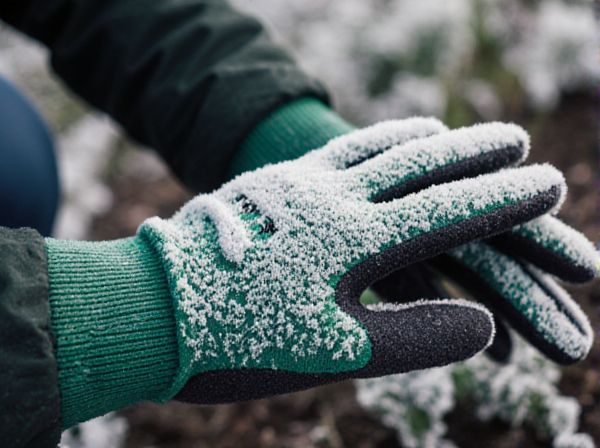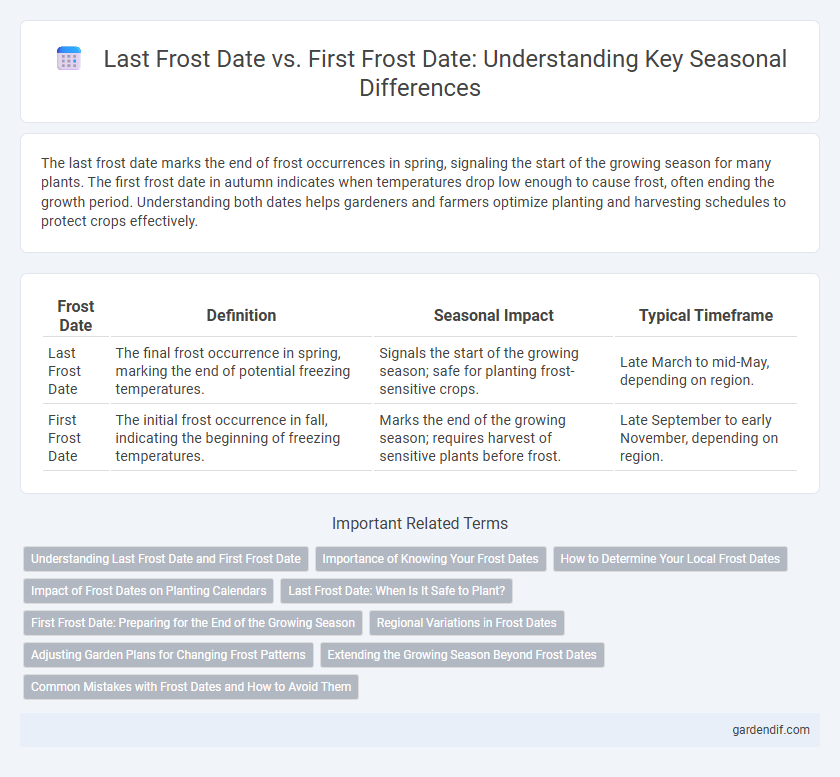
Last frost date vs First frost date Illustration
The last frost date marks the end of frost occurrences in spring, signaling the start of the growing season for many plants. The first frost date in autumn indicates when temperatures drop low enough to cause frost, often ending the growth period. Understanding both dates helps gardeners and farmers optimize planting and harvesting schedules to protect crops effectively.
Table of Comparison
| Frost Date | Definition | Seasonal Impact | Typical Timeframe |
|---|---|---|---|
| Last Frost Date | The final frost occurrence in spring, marking the end of potential freezing temperatures. | Signals the start of the growing season; safe for planting frost-sensitive crops. | Late March to mid-May, depending on region. |
| First Frost Date | The initial frost occurrence in fall, indicating the beginning of freezing temperatures. | Marks the end of the growing season; requires harvest of sensitive plants before frost. | Late September to early November, depending on region. |
Understanding Last Frost Date and First Frost Date
The last frost date marks the average calendar day when the final freezing temperature typically occurs in spring, signaling the safe start for planting frost-sensitive crops. The first frost date represents the average day in fall when temperatures first drop to freezing, indicating the end of the growing season. Understanding these frost dates helps gardeners and farmers optimize planting and harvesting schedules to protect plants from cold damage.
Importance of Knowing Your Frost Dates
Knowing your last frost date and first frost date is crucial for successful gardening and crop planning because it marks the safe period to plant frost-sensitive plants without risk of damage. Accurate frost date knowledge helps prevent seedling loss and optimizes growing seasons, ensuring maximum yield and healthy plant development. Gardeners and farmers rely on these dates to time planting and harvesting, reducing frost-related risks and enhancing overall crop productivity.
How to Determine Your Local Frost Dates
To determine your local frost dates, consult historical climate data from reliable sources such as the National Weather Service or local agricultural extensions. Utilize frost date calculators by inputting your ZIP code to obtain the average last spring frost and first fall frost dates specific to your region. Tracking local temperature trends with a home weather station can also refine these estimates for more precise gardening and planting schedules.
Impact of Frost Dates on Planting Calendars
Last frost date and first frost date are critical markers that define the safe planting period for various crops, ensuring plants avoid damaging freezes. Understanding these frost dates helps farmers and gardeners optimize planting calendars to maximize growth and yield, preventing seedling losses and promoting healthy maturation before cold weather returns. Accurate frost date data supports precision agriculture, enabling tailored crop scheduling that aligns with local climate conditions for improved productivity.
Last Frost Date: When Is It Safe to Plant?
The last frost date is the average date of the final occurrence of frost in spring, marking when temperatures consistently stay above freezing. Gardeners rely on this date to determine when it is safe to plant frost-sensitive crops, as planting before the last frost date risks damage from unexpected cold snaps. Regional climate data and historical frost records are key to accurately predicting the last frost date for successful planting and crop yield optimization.
First Frost Date: Preparing for the End of the Growing Season
The first frost date marks the critical point signaling the end of the growing season when temperatures drop below 32degF (0degC), causing damage to tender plants. Gardeners and farmers use this date to plan harvests and protect sensitive crops with mulches or row covers to prevent frost damage. Understanding the average first frost date in a specific USDA hardiness zone enables effective scheduling for seed planting and timely crop rotation.
Regional Variations in Frost Dates
Regional variations in last frost dates and first frost dates are influenced by factors such as latitude, elevation, and proximity to large water bodies. Coastal regions typically experience later last frost dates and earlier first frost dates compared to inland areas due to the moderating effects of the ocean. Mountainous regions often have extended frost periods with later last frost dates and earlier first frost dates, shortening the effective growing season.
Adjusting Garden Plans for Changing Frost Patterns
Last frost date and first frost date are critical markers for gardeners to time planting and harvesting schedules accurately. Shifts in these frost dates due to climate change require continuous monitoring of local weather patterns and historical data to adjust garden plans effectively. Utilizing frost date calculators and frost-resistant plant varieties can enhance garden resilience and optimize crop yields amid changing frost timelines.
Extending the Growing Season Beyond Frost Dates
Understanding the last frost date and first frost date is crucial for extending the growing season, as these dates define the safe planting window for frost-sensitive crops. Gardeners and farmers can maximize yield by selecting cold-tolerant plant varieties and using techniques such as row covers, cold frames, or greenhouses to protect plants from unexpected frost. Monitoring local frost date data allows for precise timing in planting and harvesting, thereby enhancing crop productivity beyond traditional frost boundaries.
Common Mistakes with Frost Dates and How to Avoid Them
Confusing the Last Frost Date with the First Frost Date leads to planting too early or harvesting too late, causing damage to crops. Misinterpreting regional climate variations and relying on outdated frost date data results in poor garden timing. To avoid these mistakes, use localized, up-to-date frost date charts and monitor daily weather forecasts closely for precise planning.
Last frost date vs First frost date Infographic

 gardendif.com
gardendif.com